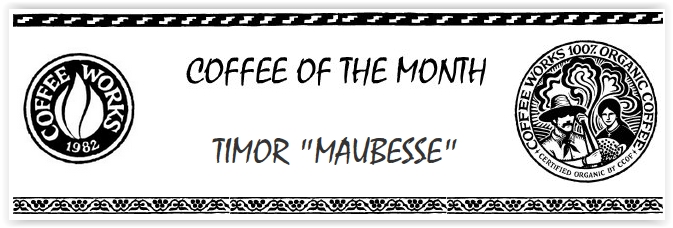Timor Maubesse (Cert. Organic)

We come again to the familiar coffee-producing neighborhood of the Malay Archipelago, the once (Dutch) East Indies. The archipelago stretches some 3300 miles wide by 1500 miles, and embraces over 4000 islands. Among these are some of the most cherished names in coffee lore: Java, Sumatra, Celebes, and Papua New Guinea. This month we are featuring the coffee of the largest and easternmost of the Lesser Sundas, the 13,200 sq. mile island of Timor.
Part of the legendary Spice Islands, Timor’s exotic past belies the fact that the Timorese have suffered greatly at the hands of foreigners. Divided between the Dutch (West) and Portugese (East) empires for centuries, in 1950 the Dutch half became part of the new nation of Indonesia. This followed invasion and occupation by the Japanese from 1942 to 1945. As elsewhere in the world, to the lasting disadvantage of the subject people, the Portugese hung on to their colonial foothold on the Eastern half of the island until 1975, when the Timorese people rebelled and declared their independence as East Timor.

Indonesia immediately invaded and annexed East Timor, setting the stage for a guerrilla civil war and brutal repression, during which more than 500,000 people perished. Efforts to integrate Timor into greater Indonesia have encountered many problems, ranging from religious differences (the Timorese are largely Catholics, the Indonesians are Muslim), linguistic/cultural, and nationalistic.
The cultivation of Arabica coffees on Timor was introduced by Dutch traders in the Seventeenth century. While Timor’s mostly mountainous topography is naturally favorable to coffee, unlike the rest of Indonesia rainfall is limited to a three month period. Annual production is 5.6 million bags, of which 1.4 million are consumed domestically and the rest exported. Ninety percent of production is in the hands of smallholders, which is what gives Timor coffee its handcrafted, homegrown flavor. Recent efforts to improve quality have resulted in major gains. Timor’s export arabicas are now brought to modern processing facilities, where they are processed by the washed method and laid out on cement patios to be sundried. The Organic Crop Improvement Association (OCIA) certifies much of the crop, including our selection this month, as organically-grown. Timor’s export quality coffee is divided into “Aifu” grade (grown under 1700 meters elevation) and “Maubesse” (grown above 1700 m).
One of the things which makes coffee tasting so satisfying is the large number of variables which go into producing the cup in hand. With Timor we have a strong coffee-growing tradition, from a celebrated coffee-producing region, using traditional varieties and processing methods. How does it compare with its natural-processed neighbor Sumatra, or its reknowned wet-processed neighbor Celebes? Does it possess the full bodied smoothness of other Indonesians, their lack of acidity, or does it share the brightness of Papua New Guinea? We are still experimenting with different degrees of roast for Timor. Judgement on this coffee is unrendered. Consider it a dialog: You tell me what you like about it and I’ll tell you what I like. It is after all a matter of taste. We are in this together, for the journey of discovery, with nothing to lead us but our perceptions.


